ITSU2004 - Sports Report Information System Design and Analysis Report
VerifiedAdded on 2023/06/11
|19
|2817
|488
Report
AI Summary
This report presents a comprehensive design and analysis of a Sports Report Information System for Allsports club, addressing the challenges of managing club activities, newsletters, and member information. It explores two system development approaches: structured and agile, ultimately selecting the agile approach for its adaptability and collaborative nature. The report details data gathering techniques, including questionnaires and interviews, and outlines both functional and non-functional requirements for the proposed system. Furthermore, it includes key system design elements such as class diagrams, use case diagrams and scenarios, an entity-relationship diagram, and data flow diagrams. The report concludes by highlighting the system's ability to streamline newsletter publication, improve member communication, and enhance overall club management efficiency.
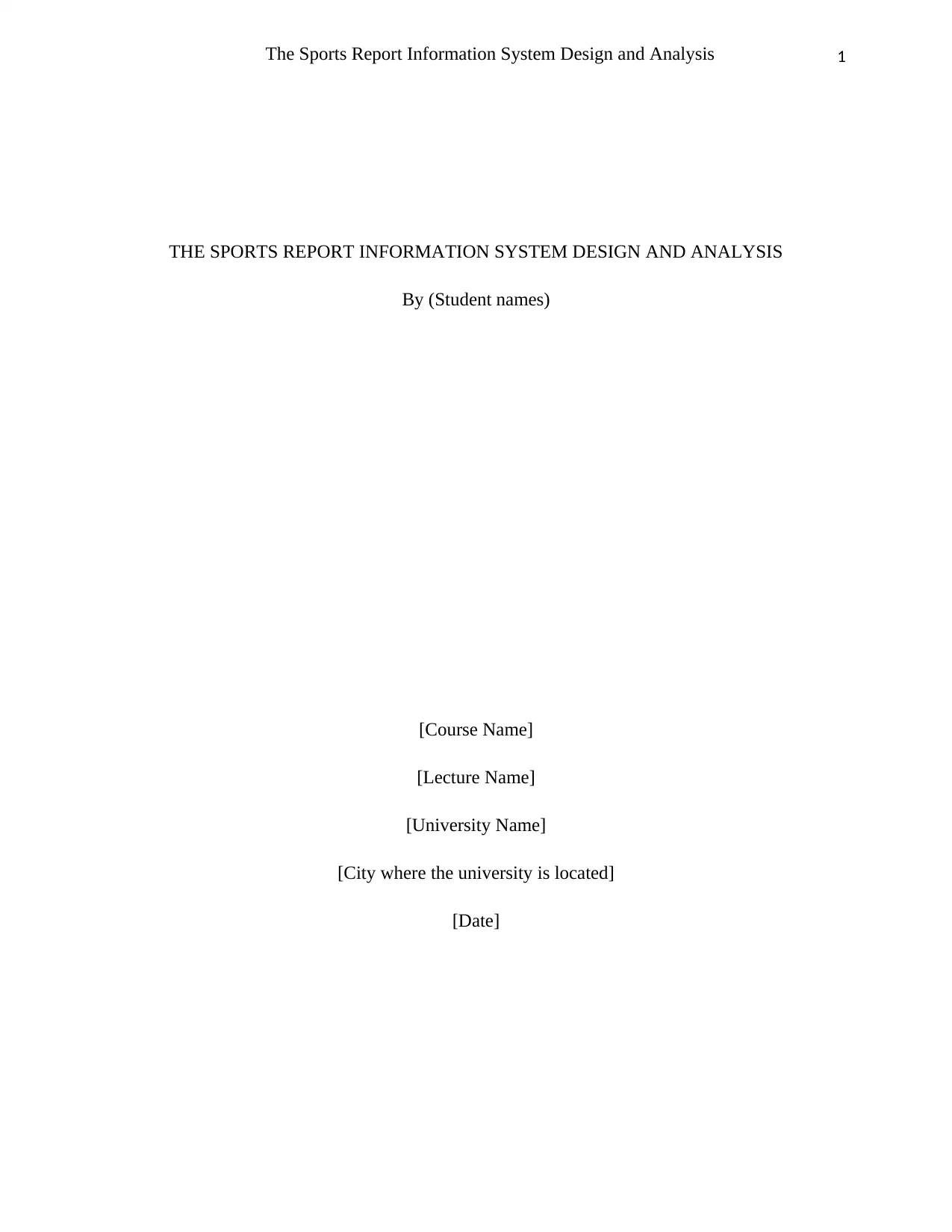
1The Sports Report Information System Design and Analysis
THE SPORTS REPORT INFORMATION SYSTEM DESIGN AND ANALYSIS
By (Student names)
[Course Name]
[Lecture Name]
[University Name]
[City where the university is located]
[Date]
THE SPORTS REPORT INFORMATION SYSTEM DESIGN AND ANALYSIS
By (Student names)
[Course Name]
[Lecture Name]
[University Name]
[City where the university is located]
[Date]
Secure Best Marks with AI Grader
Need help grading? Try our AI Grader for instant feedback on your assignments.
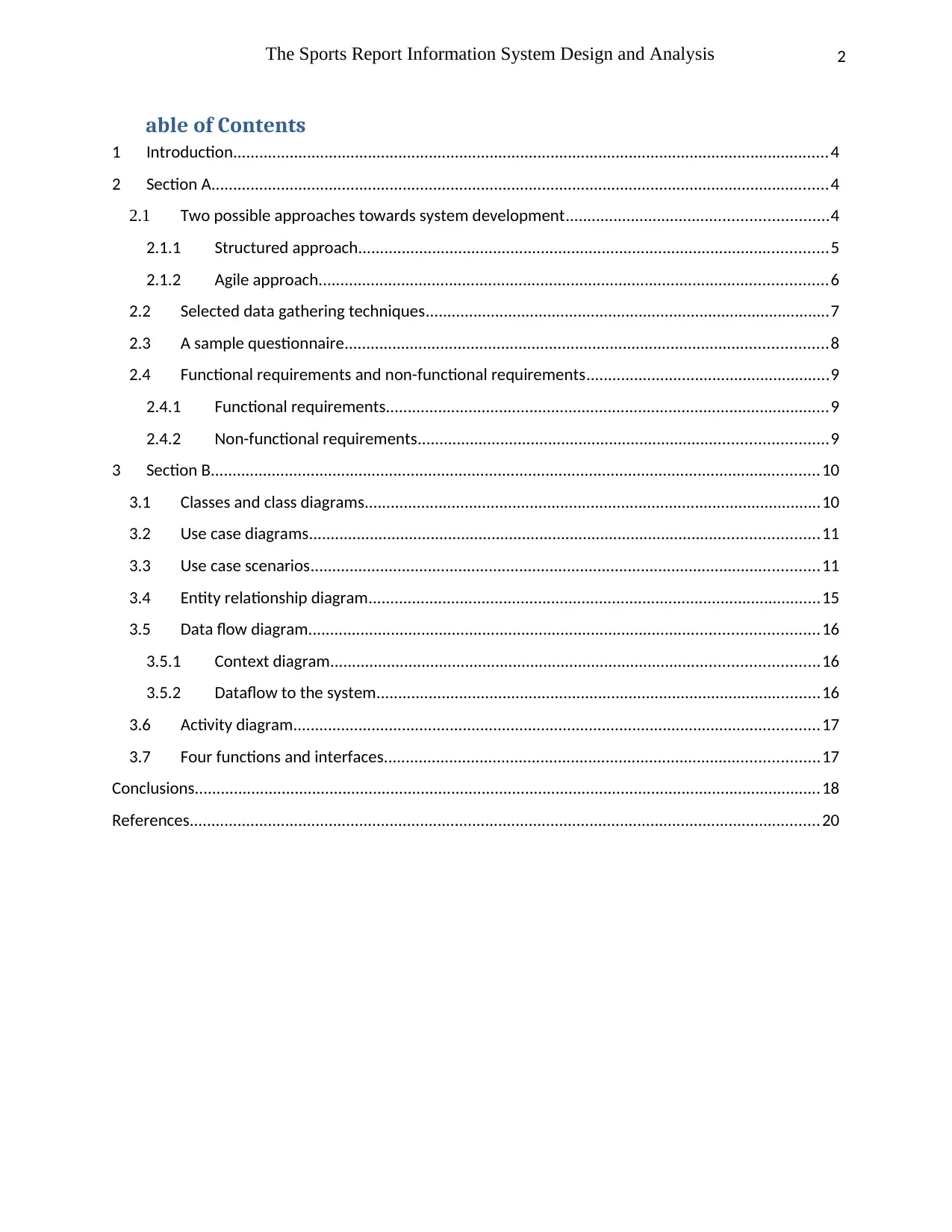
2The Sports Report Information System Design and Analysis
able of Contents
1 Introduction.........................................................................................................................................4
2 Section A..............................................................................................................................................4
2.1 Two possible approaches towards system development............................................................4
2.1.1 Structured approach............................................................................................................5
2.1.2 Agile approach.....................................................................................................................6
2.2 Selected data gathering techniques.............................................................................................7
2.3 A sample questionnaire...............................................................................................................8
2.4 Functional requirements and non-functional requirements........................................................9
2.4.1 Functional requirements......................................................................................................9
2.4.2 Non-functional requirements..............................................................................................9
3 Section B............................................................................................................................................10
3.1 Classes and class diagrams.........................................................................................................10
3.2 Use case diagrams.....................................................................................................................11
3.3 Use case scenarios.....................................................................................................................11
3.4 Entity relationship diagram........................................................................................................15
3.5 Data flow diagram.....................................................................................................................16
3.5.1 Context diagram................................................................................................................16
3.5.2 Dataflow to the system......................................................................................................16
3.6 Activity diagram.........................................................................................................................17
3.7 Four functions and interfaces....................................................................................................17
Conclusions................................................................................................................................................18
References.................................................................................................................................................20
able of Contents
1 Introduction.........................................................................................................................................4
2 Section A..............................................................................................................................................4
2.1 Two possible approaches towards system development............................................................4
2.1.1 Structured approach............................................................................................................5
2.1.2 Agile approach.....................................................................................................................6
2.2 Selected data gathering techniques.............................................................................................7
2.3 A sample questionnaire...............................................................................................................8
2.4 Functional requirements and non-functional requirements........................................................9
2.4.1 Functional requirements......................................................................................................9
2.4.2 Non-functional requirements..............................................................................................9
3 Section B............................................................................................................................................10
3.1 Classes and class diagrams.........................................................................................................10
3.2 Use case diagrams.....................................................................................................................11
3.3 Use case scenarios.....................................................................................................................11
3.4 Entity relationship diagram........................................................................................................15
3.5 Data flow diagram.....................................................................................................................16
3.5.1 Context diagram................................................................................................................16
3.5.2 Dataflow to the system......................................................................................................16
3.6 Activity diagram.........................................................................................................................17
3.7 Four functions and interfaces....................................................................................................17
Conclusions................................................................................................................................................18
References.................................................................................................................................................20
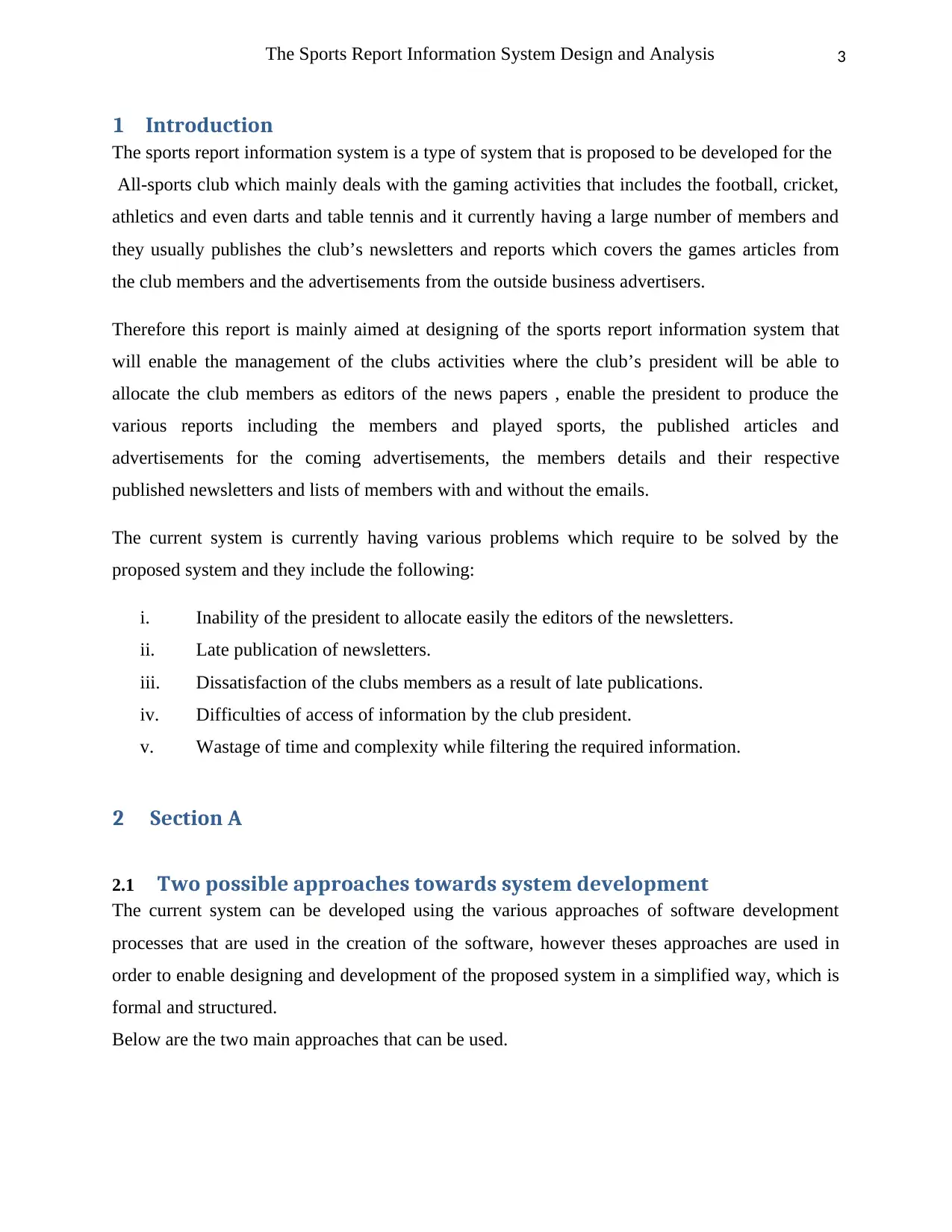
3The Sports Report Information System Design and Analysis
1 Introduction
The sports report information system is a type of system that is proposed to be developed for the
All-sports club which mainly deals with the gaming activities that includes the football, cricket,
athletics and even darts and table tennis and it currently having a large number of members and
they usually publishes the club’s newsletters and reports which covers the games articles from
the club members and the advertisements from the outside business advertisers.
Therefore this report is mainly aimed at designing of the sports report information system that
will enable the management of the clubs activities where the club’s president will be able to
allocate the club members as editors of the news papers , enable the president to produce the
various reports including the members and played sports, the published articles and
advertisements for the coming advertisements, the members details and their respective
published newsletters and lists of members with and without the emails.
The current system is currently having various problems which require to be solved by the
proposed system and they include the following:
i. Inability of the president to allocate easily the editors of the newsletters.
ii. Late publication of newsletters.
iii. Dissatisfaction of the clubs members as a result of late publications.
iv. Difficulties of access of information by the club president.
v. Wastage of time and complexity while filtering the required information.
2 Section A
2.1 Two possible approaches towards system development
The current system can be developed using the various approaches of software development
processes that are used in the creation of the software, however theses approaches are used in
order to enable designing and development of the proposed system in a simplified way, which is
formal and structured.
Below are the two main approaches that can be used.
1 Introduction
The sports report information system is a type of system that is proposed to be developed for the
All-sports club which mainly deals with the gaming activities that includes the football, cricket,
athletics and even darts and table tennis and it currently having a large number of members and
they usually publishes the club’s newsletters and reports which covers the games articles from
the club members and the advertisements from the outside business advertisers.
Therefore this report is mainly aimed at designing of the sports report information system that
will enable the management of the clubs activities where the club’s president will be able to
allocate the club members as editors of the news papers , enable the president to produce the
various reports including the members and played sports, the published articles and
advertisements for the coming advertisements, the members details and their respective
published newsletters and lists of members with and without the emails.
The current system is currently having various problems which require to be solved by the
proposed system and they include the following:
i. Inability of the president to allocate easily the editors of the newsletters.
ii. Late publication of newsletters.
iii. Dissatisfaction of the clubs members as a result of late publications.
iv. Difficulties of access of information by the club president.
v. Wastage of time and complexity while filtering the required information.
2 Section A
2.1 Two possible approaches towards system development
The current system can be developed using the various approaches of software development
processes that are used in the creation of the software, however theses approaches are used in
order to enable designing and development of the proposed system in a simplified way, which is
formal and structured.
Below are the two main approaches that can be used.
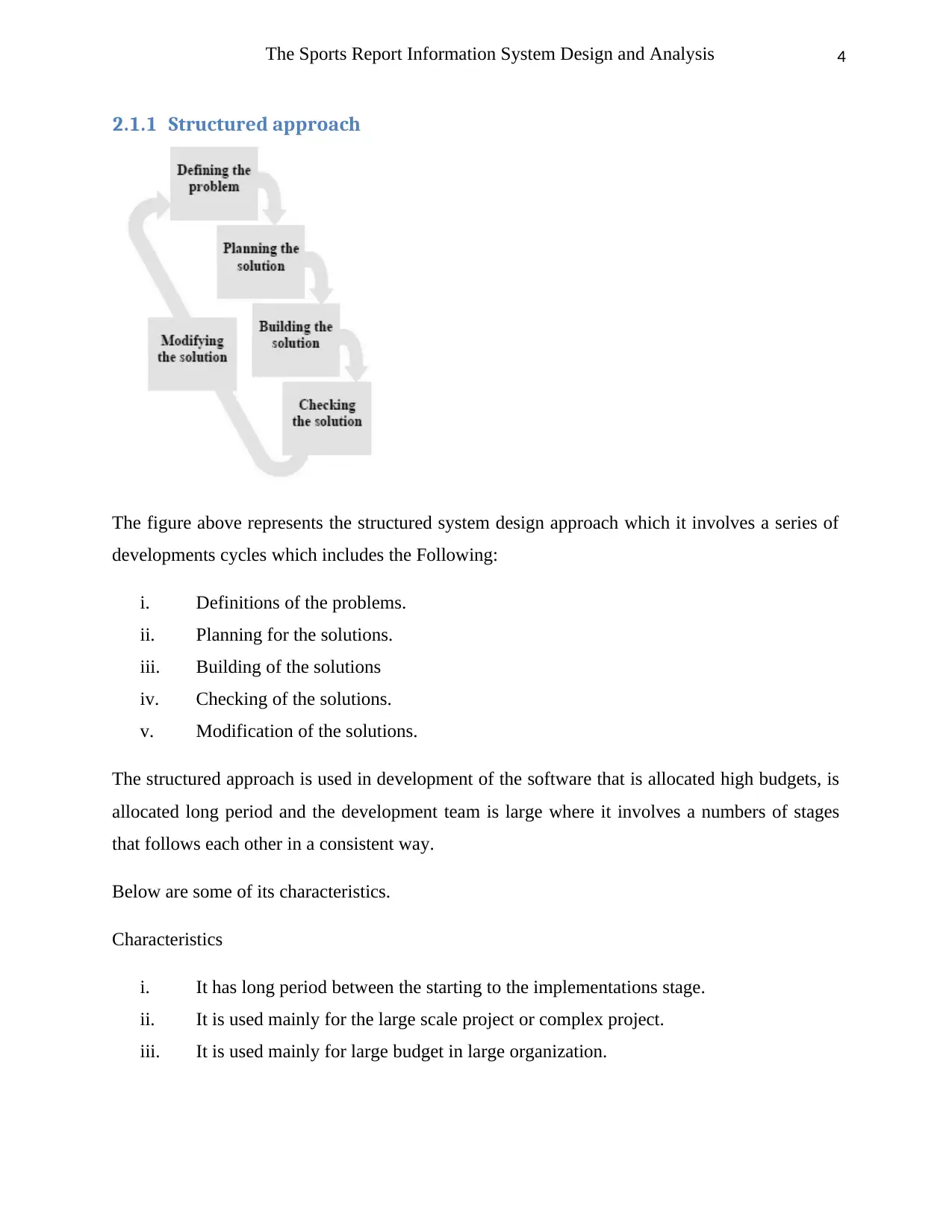
4The Sports Report Information System Design and Analysis
2.1.1 Structured approach
The figure above represents the structured system design approach which it involves a series of
developments cycles which includes the Following:
i. Definitions of the problems.
ii. Planning for the solutions.
iii. Building of the solutions
iv. Checking of the solutions.
v. Modification of the solutions.
The structured approach is used in development of the software that is allocated high budgets, is
allocated long period and the development team is large where it involves a numbers of stages
that follows each other in a consistent way.
Below are some of its characteristics.
Characteristics
i. It has long period between the starting to the implementations stage.
ii. It is used mainly for the large scale project or complex project.
iii. It is used mainly for large budget in large organization.
2.1.1 Structured approach
The figure above represents the structured system design approach which it involves a series of
developments cycles which includes the Following:
i. Definitions of the problems.
ii. Planning for the solutions.
iii. Building of the solutions
iv. Checking of the solutions.
v. Modification of the solutions.
The structured approach is used in development of the software that is allocated high budgets, is
allocated long period and the development team is large where it involves a numbers of stages
that follows each other in a consistent way.
Below are some of its characteristics.
Characteristics
i. It has long period between the starting to the implementations stage.
ii. It is used mainly for the large scale project or complex project.
iii. It is used mainly for large budget in large organization.
Secure Best Marks with AI Grader
Need help grading? Try our AI Grader for instant feedback on your assignments.
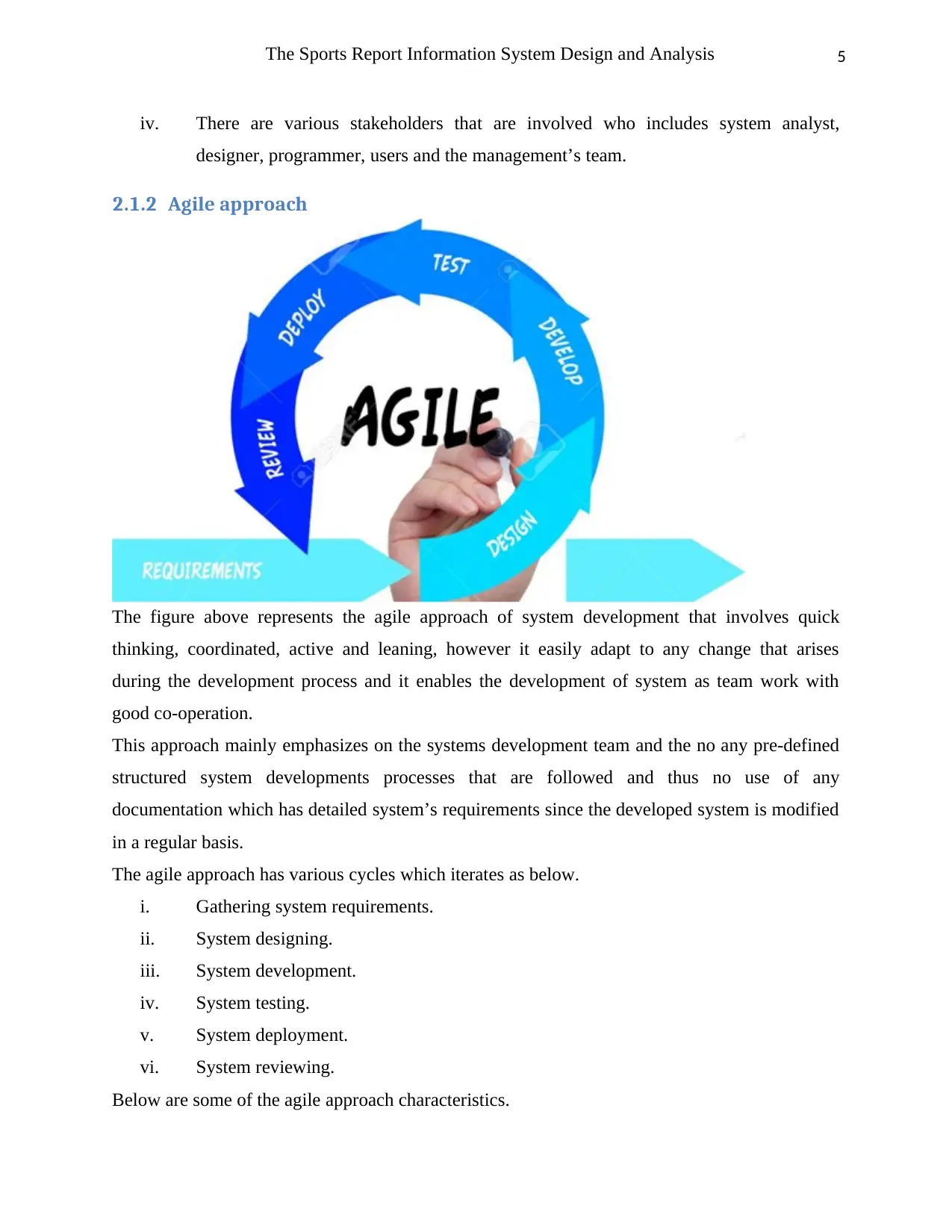
5The Sports Report Information System Design and Analysis
iv. There are various stakeholders that are involved who includes system analyst,
designer, programmer, users and the management’s team.
2.1.2 Agile approach
The figure above represents the agile approach of system development that involves quick
thinking, coordinated, active and leaning, however it easily adapt to any change that arises
during the development process and it enables the development of system as team work with
good co-operation.
This approach mainly emphasizes on the systems development team and the no any pre-defined
structured system developments processes that are followed and thus no use of any
documentation which has detailed system’s requirements since the developed system is modified
in a regular basis.
The agile approach has various cycles which iterates as below.
i. Gathering system requirements.
ii. System designing.
iii. System development.
iv. System testing.
v. System deployment.
vi. System reviewing.
Below are some of the agile approach characteristics.
iv. There are various stakeholders that are involved who includes system analyst,
designer, programmer, users and the management’s team.
2.1.2 Agile approach
The figure above represents the agile approach of system development that involves quick
thinking, coordinated, active and leaning, however it easily adapt to any change that arises
during the development process and it enables the development of system as team work with
good co-operation.
This approach mainly emphasizes on the systems development team and the no any pre-defined
structured system developments processes that are followed and thus no use of any
documentation which has detailed system’s requirements since the developed system is modified
in a regular basis.
The agile approach has various cycles which iterates as below.
i. Gathering system requirements.
ii. System designing.
iii. System development.
iv. System testing.
v. System deployment.
vi. System reviewing.
Below are some of the agile approach characteristics.
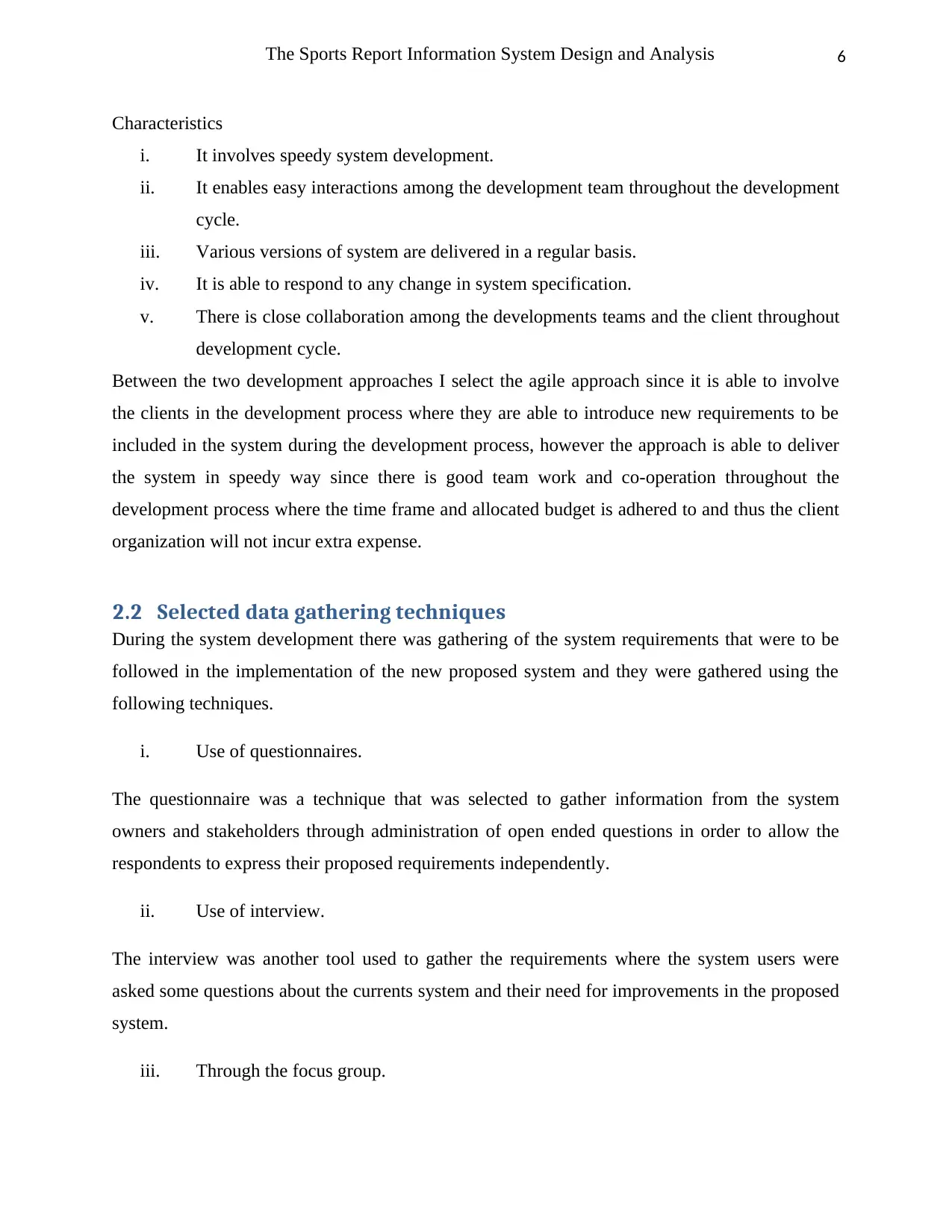
6The Sports Report Information System Design and Analysis
Characteristics
i. It involves speedy system development.
ii. It enables easy interactions among the development team throughout the development
cycle.
iii. Various versions of system are delivered in a regular basis.
iv. It is able to respond to any change in system specification.
v. There is close collaboration among the developments teams and the client throughout
development cycle.
Between the two development approaches I select the agile approach since it is able to involve
the clients in the development process where they are able to introduce new requirements to be
included in the system during the development process, however the approach is able to deliver
the system in speedy way since there is good team work and co-operation throughout the
development process where the time frame and allocated budget is adhered to and thus the client
organization will not incur extra expense.
2.2 Selected data gathering techniques
During the system development there was gathering of the system requirements that were to be
followed in the implementation of the new proposed system and they were gathered using the
following techniques.
i. Use of questionnaires.
The questionnaire was a technique that was selected to gather information from the system
owners and stakeholders through administration of open ended questions in order to allow the
respondents to express their proposed requirements independently.
ii. Use of interview.
The interview was another tool used to gather the requirements where the system users were
asked some questions about the currents system and their need for improvements in the proposed
system.
iii. Through the focus group.
Characteristics
i. It involves speedy system development.
ii. It enables easy interactions among the development team throughout the development
cycle.
iii. Various versions of system are delivered in a regular basis.
iv. It is able to respond to any change in system specification.
v. There is close collaboration among the developments teams and the client throughout
development cycle.
Between the two development approaches I select the agile approach since it is able to involve
the clients in the development process where they are able to introduce new requirements to be
included in the system during the development process, however the approach is able to deliver
the system in speedy way since there is good team work and co-operation throughout the
development process where the time frame and allocated budget is adhered to and thus the client
organization will not incur extra expense.
2.2 Selected data gathering techniques
During the system development there was gathering of the system requirements that were to be
followed in the implementation of the new proposed system and they were gathered using the
following techniques.
i. Use of questionnaires.
The questionnaire was a technique that was selected to gather information from the system
owners and stakeholders through administration of open ended questions in order to allow the
respondents to express their proposed requirements independently.
ii. Use of interview.
The interview was another tool used to gather the requirements where the system users were
asked some questions about the currents system and their need for improvements in the proposed
system.
iii. Through the focus group.
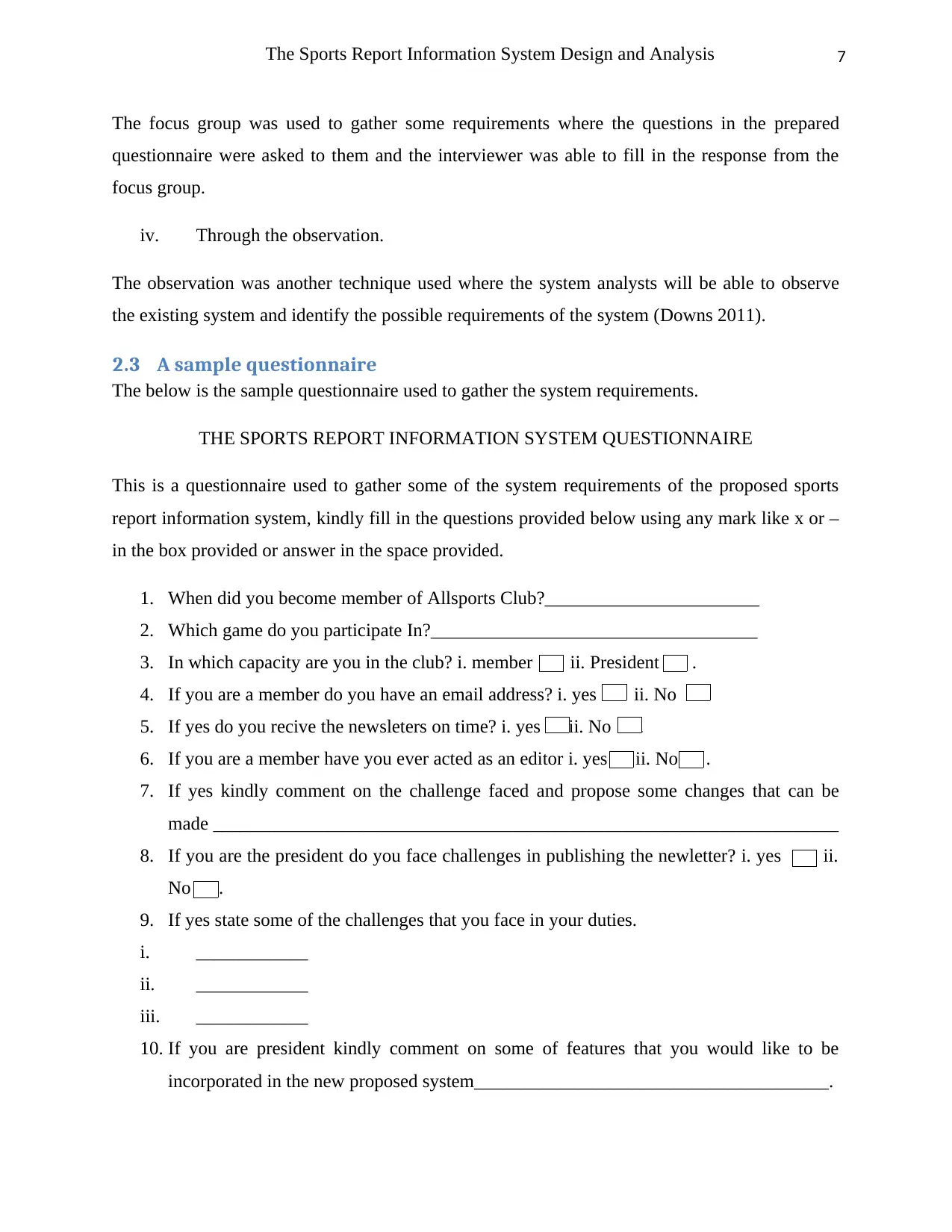
7The Sports Report Information System Design and Analysis
The focus group was used to gather some requirements where the questions in the prepared
questionnaire were asked to them and the interviewer was able to fill in the response from the
focus group.
iv. Through the observation.
The observation was another technique used where the system analysts will be able to observe
the existing system and identify the possible requirements of the system (Downs 2011).
2.3 A sample questionnaire
The below is the sample questionnaire used to gather the system requirements.
THE SPORTS REPORT INFORMATION SYSTEM QUESTIONNAIRE
This is a questionnaire used to gather some of the system requirements of the proposed sports
report information system, kindly fill in the questions provided below using any mark like x or –
in the box provided or answer in the space provided.
1. When did you become member of Allsports Club?_______________________
2. Which game do you participate In?___________________________________
3. In which capacity are you in the club? i. member ii. President .
4. If you are a member do you have an email address? i. yes ii. No .
5. If yes do you recive the newsleters on time? i. yes ii. No .
6. If you are a member have you ever acted as an editor i. yes ii. No .
7. If yes kindly comment on the challenge faced and propose some changes that can be
made ___________________________________________________________________
8. If you are the president do you face challenges in publishing the newletter? i. yes ii.
No .
9. If yes state some of the challenges that you face in your duties.
i. ____________
ii. ____________
iii. ____________
10. If you are president kindly comment on some of features that you would like to be
incorporated in the new proposed system______________________________________.
The focus group was used to gather some requirements where the questions in the prepared
questionnaire were asked to them and the interviewer was able to fill in the response from the
focus group.
iv. Through the observation.
The observation was another technique used where the system analysts will be able to observe
the existing system and identify the possible requirements of the system (Downs 2011).
2.3 A sample questionnaire
The below is the sample questionnaire used to gather the system requirements.
THE SPORTS REPORT INFORMATION SYSTEM QUESTIONNAIRE
This is a questionnaire used to gather some of the system requirements of the proposed sports
report information system, kindly fill in the questions provided below using any mark like x or –
in the box provided or answer in the space provided.
1. When did you become member of Allsports Club?_______________________
2. Which game do you participate In?___________________________________
3. In which capacity are you in the club? i. member ii. President .
4. If you are a member do you have an email address? i. yes ii. No .
5. If yes do you recive the newsleters on time? i. yes ii. No .
6. If you are a member have you ever acted as an editor i. yes ii. No .
7. If yes kindly comment on the challenge faced and propose some changes that can be
made ___________________________________________________________________
8. If you are the president do you face challenges in publishing the newletter? i. yes ii.
No .
9. If yes state some of the challenges that you face in your duties.
i. ____________
ii. ____________
iii. ____________
10. If you are president kindly comment on some of features that you would like to be
incorporated in the new proposed system______________________________________.
Paraphrase This Document
Need a fresh take? Get an instant paraphrase of this document with our AI Paraphraser
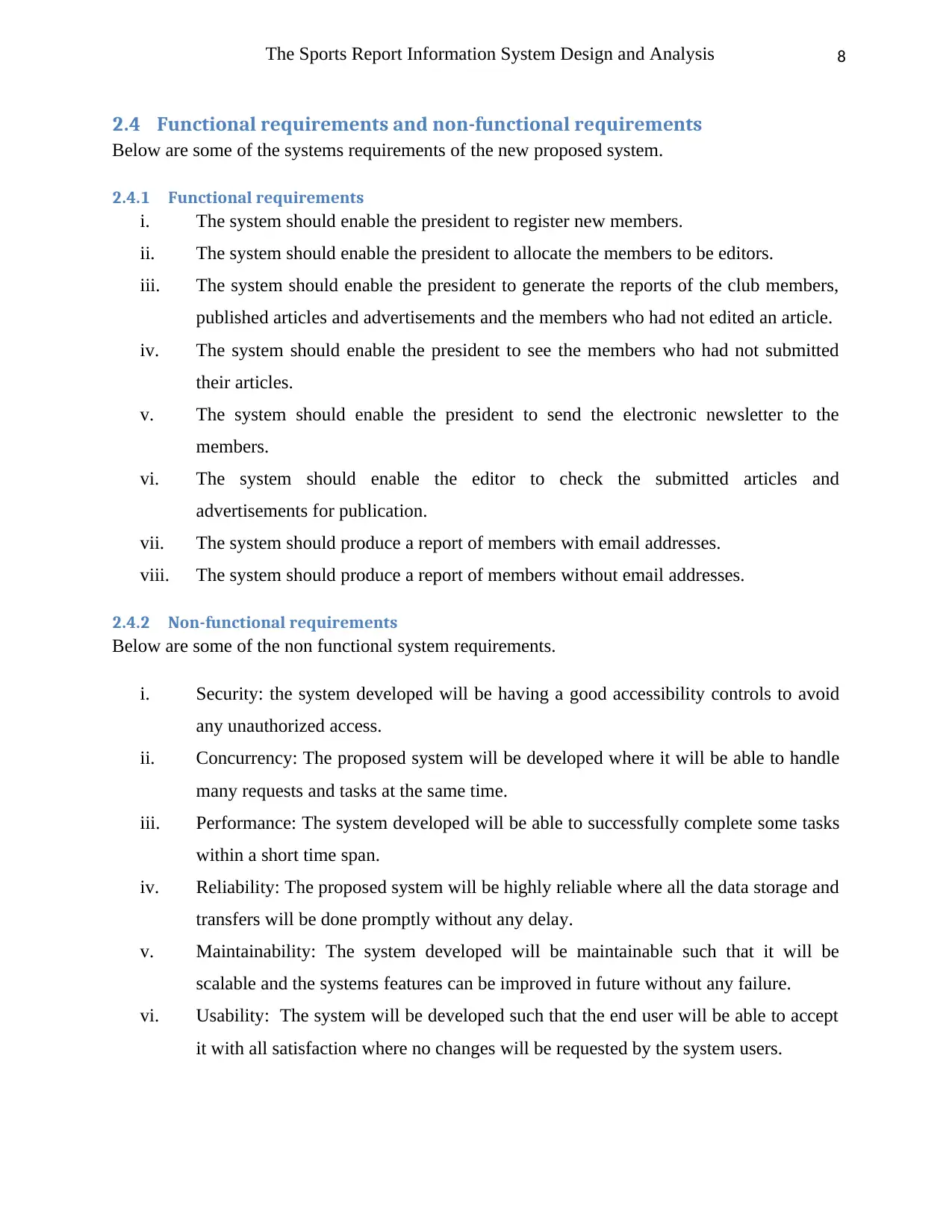
8The Sports Report Information System Design and Analysis
2.4 Functional requirements and non-functional requirements
Below are some of the systems requirements of the new proposed system.
2.4.1 Functional requirements
i. The system should enable the president to register new members.
ii. The system should enable the president to allocate the members to be editors.
iii. The system should enable the president to generate the reports of the club members,
published articles and advertisements and the members who had not edited an article.
iv. The system should enable the president to see the members who had not submitted
their articles.
v. The system should enable the president to send the electronic newsletter to the
members.
vi. The system should enable the editor to check the submitted articles and
advertisements for publication.
vii. The system should produce a report of members with email addresses.
viii. The system should produce a report of members without email addresses.
2.4.2 Non-functional requirements
Below are some of the non functional system requirements.
i. Security: the system developed will be having a good accessibility controls to avoid
any unauthorized access.
ii. Concurrency: The proposed system will be developed where it will be able to handle
many requests and tasks at the same time.
iii. Performance: The system developed will be able to successfully complete some tasks
within a short time span.
iv. Reliability: The proposed system will be highly reliable where all the data storage and
transfers will be done promptly without any delay.
v. Maintainability: The system developed will be maintainable such that it will be
scalable and the systems features can be improved in future without any failure.
vi. Usability: The system will be developed such that the end user will be able to accept
it with all satisfaction where no changes will be requested by the system users.
2.4 Functional requirements and non-functional requirements
Below are some of the systems requirements of the new proposed system.
2.4.1 Functional requirements
i. The system should enable the president to register new members.
ii. The system should enable the president to allocate the members to be editors.
iii. The system should enable the president to generate the reports of the club members,
published articles and advertisements and the members who had not edited an article.
iv. The system should enable the president to see the members who had not submitted
their articles.
v. The system should enable the president to send the electronic newsletter to the
members.
vi. The system should enable the editor to check the submitted articles and
advertisements for publication.
vii. The system should produce a report of members with email addresses.
viii. The system should produce a report of members without email addresses.
2.4.2 Non-functional requirements
Below are some of the non functional system requirements.
i. Security: the system developed will be having a good accessibility controls to avoid
any unauthorized access.
ii. Concurrency: The proposed system will be developed where it will be able to handle
many requests and tasks at the same time.
iii. Performance: The system developed will be able to successfully complete some tasks
within a short time span.
iv. Reliability: The proposed system will be highly reliable where all the data storage and
transfers will be done promptly without any delay.
v. Maintainability: The system developed will be maintainable such that it will be
scalable and the systems features can be improved in future without any failure.
vi. Usability: The system will be developed such that the end user will be able to accept
it with all satisfaction where no changes will be requested by the system users.
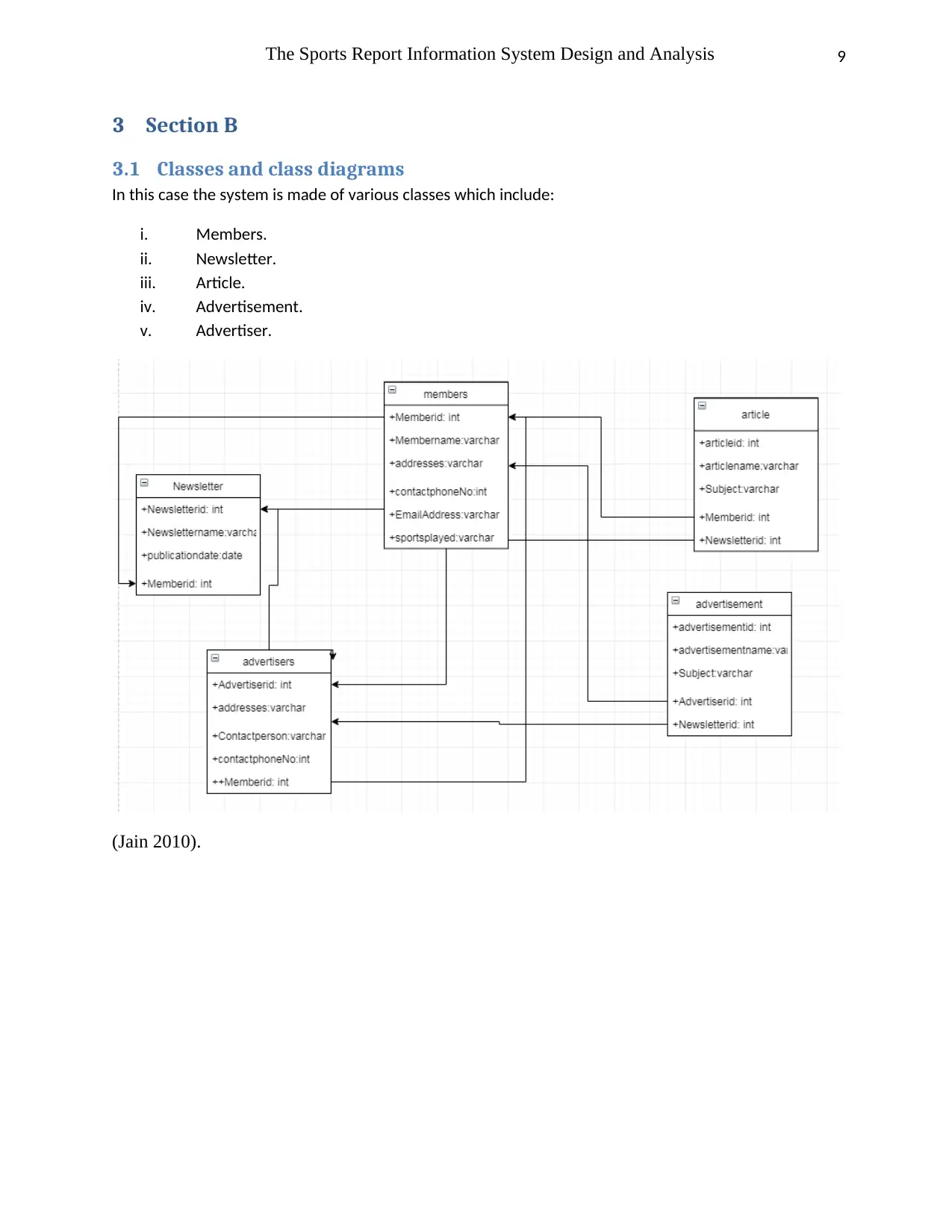
9The Sports Report Information System Design and Analysis
3 Section B
3.1 Classes and class diagrams
In this case the system is made of various classes which include:
i. Members.
ii. Newsletter.
iii. Article.
iv. Advertisement.
v. Advertiser.
(Jain 2010).
3 Section B
3.1 Classes and class diagrams
In this case the system is made of various classes which include:
i. Members.
ii. Newsletter.
iii. Article.
iv. Advertisement.
v. Advertiser.
(Jain 2010).
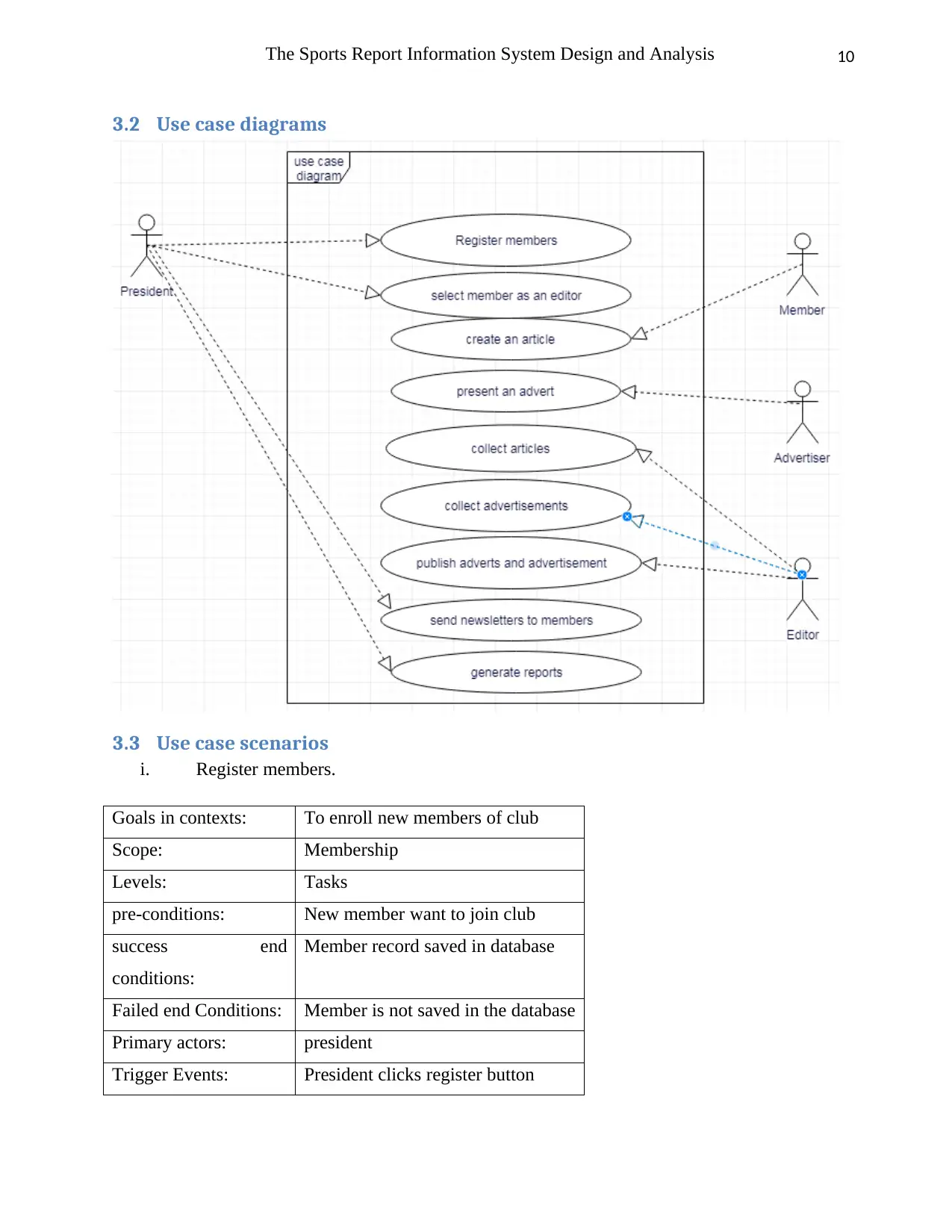
10The Sports Report Information System Design and Analysis
3.2 Use case diagrams
3.3 Use case scenarios
i. Register members.
Goals in contexts: To enroll new members of club
Scope: Membership
Levels: Tasks
pre-conditions: New member want to join club
success end
conditions:
Member record saved in database
Failed end Conditions: Member is not saved in the database
Primary actors: president
Trigger Events: President clicks register button
3.2 Use case diagrams
3.3 Use case scenarios
i. Register members.
Goals in contexts: To enroll new members of club
Scope: Membership
Levels: Tasks
pre-conditions: New member want to join club
success end
conditions:
Member record saved in database
Failed end Conditions: Member is not saved in the database
Primary actors: president
Trigger Events: President clicks register button
Secure Best Marks with AI Grader
Need help grading? Try our AI Grader for instant feedback on your assignments.
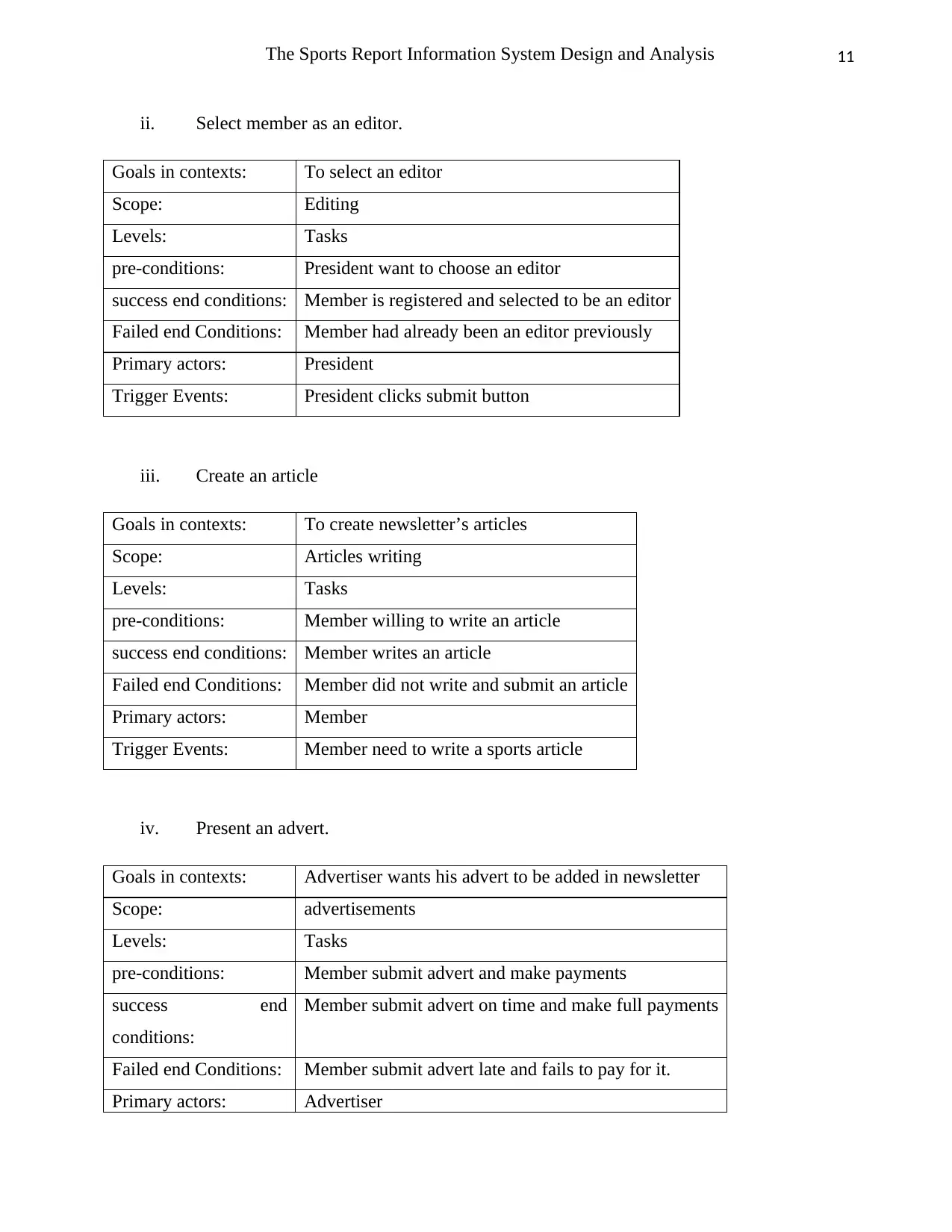
11The Sports Report Information System Design and Analysis
ii. Select member as an editor.
Goals in contexts: To select an editor
Scope: Editing
Levels: Tasks
pre-conditions: President want to choose an editor
success end conditions: Member is registered and selected to be an editor
Failed end Conditions: Member had already been an editor previously
Primary actors: President
Trigger Events: President clicks submit button
iii. Create an article
Goals in contexts: To create newsletter’s articles
Scope: Articles writing
Levels: Tasks
pre-conditions: Member willing to write an article
success end conditions: Member writes an article
Failed end Conditions: Member did not write and submit an article
Primary actors: Member
Trigger Events: Member need to write a sports article
iv. Present an advert.
Goals in contexts: Advertiser wants his advert to be added in newsletter
Scope: advertisements
Levels: Tasks
pre-conditions: Member submit advert and make payments
success end
conditions:
Member submit advert on time and make full payments
Failed end Conditions: Member submit advert late and fails to pay for it.
Primary actors: Advertiser
ii. Select member as an editor.
Goals in contexts: To select an editor
Scope: Editing
Levels: Tasks
pre-conditions: President want to choose an editor
success end conditions: Member is registered and selected to be an editor
Failed end Conditions: Member had already been an editor previously
Primary actors: President
Trigger Events: President clicks submit button
iii. Create an article
Goals in contexts: To create newsletter’s articles
Scope: Articles writing
Levels: Tasks
pre-conditions: Member willing to write an article
success end conditions: Member writes an article
Failed end Conditions: Member did not write and submit an article
Primary actors: Member
Trigger Events: Member need to write a sports article
iv. Present an advert.
Goals in contexts: Advertiser wants his advert to be added in newsletter
Scope: advertisements
Levels: Tasks
pre-conditions: Member submit advert and make payments
success end
conditions:
Member submit advert on time and make full payments
Failed end Conditions: Member submit advert late and fails to pay for it.
Primary actors: Advertiser
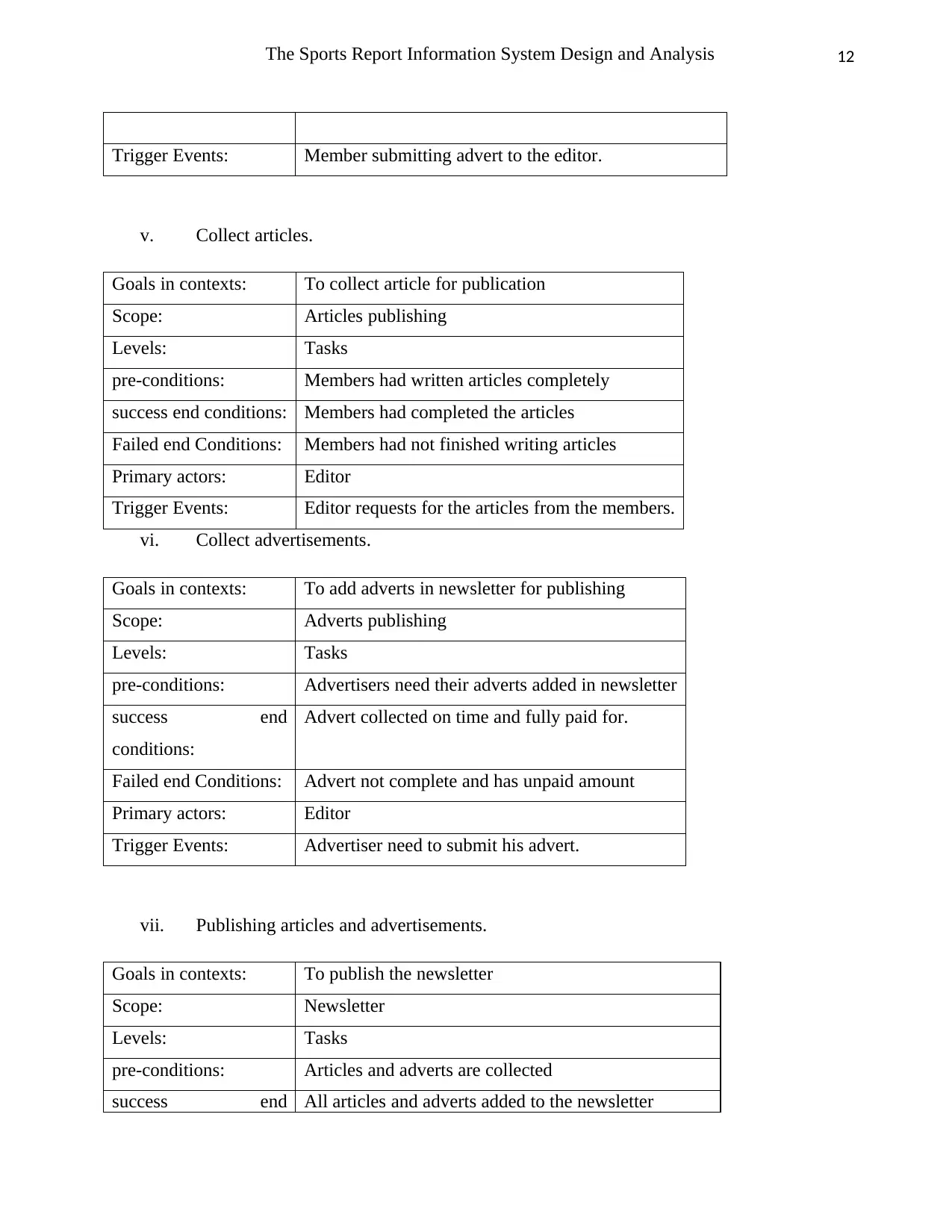
12The Sports Report Information System Design and Analysis
Trigger Events: Member submitting advert to the editor.
v. Collect articles.
Goals in contexts: To collect article for publication
Scope: Articles publishing
Levels: Tasks
pre-conditions: Members had written articles completely
success end conditions: Members had completed the articles
Failed end Conditions: Members had not finished writing articles
Primary actors: Editor
Trigger Events: Editor requests for the articles from the members.
vi. Collect advertisements.
Goals in contexts: To add adverts in newsletter for publishing
Scope: Adverts publishing
Levels: Tasks
pre-conditions: Advertisers need their adverts added in newsletter
success end
conditions:
Advert collected on time and fully paid for.
Failed end Conditions: Advert not complete and has unpaid amount
Primary actors: Editor
Trigger Events: Advertiser need to submit his advert.
vii. Publishing articles and advertisements.
Goals in contexts: To publish the newsletter
Scope: Newsletter
Levels: Tasks
pre-conditions: Articles and adverts are collected
success end All articles and adverts added to the newsletter
Trigger Events: Member submitting advert to the editor.
v. Collect articles.
Goals in contexts: To collect article for publication
Scope: Articles publishing
Levels: Tasks
pre-conditions: Members had written articles completely
success end conditions: Members had completed the articles
Failed end Conditions: Members had not finished writing articles
Primary actors: Editor
Trigger Events: Editor requests for the articles from the members.
vi. Collect advertisements.
Goals in contexts: To add adverts in newsletter for publishing
Scope: Adverts publishing
Levels: Tasks
pre-conditions: Advertisers need their adverts added in newsletter
success end
conditions:
Advert collected on time and fully paid for.
Failed end Conditions: Advert not complete and has unpaid amount
Primary actors: Editor
Trigger Events: Advertiser need to submit his advert.
vii. Publishing articles and advertisements.
Goals in contexts: To publish the newsletter
Scope: Newsletter
Levels: Tasks
pre-conditions: Articles and adverts are collected
success end All articles and adverts added to the newsletter
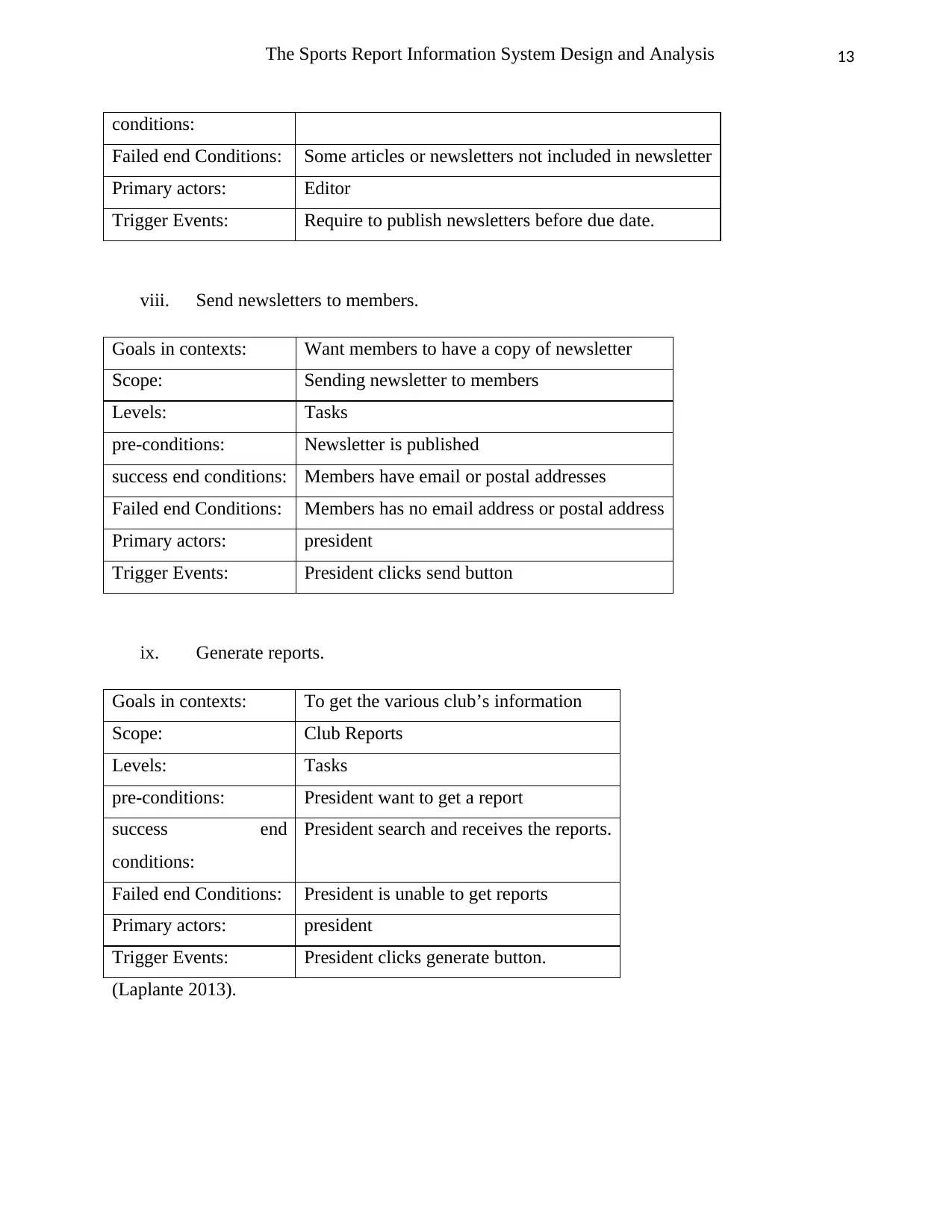
13The Sports Report Information System Design and Analysis
conditions:
Failed end Conditions: Some articles or newsletters not included in newsletter
Primary actors: Editor
Trigger Events: Require to publish newsletters before due date.
viii. Send newsletters to members.
Goals in contexts: Want members to have a copy of newsletter
Scope: Sending newsletter to members
Levels: Tasks
pre-conditions: Newsletter is published
success end conditions: Members have email or postal addresses
Failed end Conditions: Members has no email address or postal address
Primary actors: president
Trigger Events: President clicks send button
ix. Generate reports.
Goals in contexts: To get the various club’s information
Scope: Club Reports
Levels: Tasks
pre-conditions: President want to get a report
success end
conditions:
President search and receives the reports.
Failed end Conditions: President is unable to get reports
Primary actors: president
Trigger Events: President clicks generate button.
(Laplante 2013).
conditions:
Failed end Conditions: Some articles or newsletters not included in newsletter
Primary actors: Editor
Trigger Events: Require to publish newsletters before due date.
viii. Send newsletters to members.
Goals in contexts: Want members to have a copy of newsletter
Scope: Sending newsletter to members
Levels: Tasks
pre-conditions: Newsletter is published
success end conditions: Members have email or postal addresses
Failed end Conditions: Members has no email address or postal address
Primary actors: president
Trigger Events: President clicks send button
ix. Generate reports.
Goals in contexts: To get the various club’s information
Scope: Club Reports
Levels: Tasks
pre-conditions: President want to get a report
success end
conditions:
President search and receives the reports.
Failed end Conditions: President is unable to get reports
Primary actors: president
Trigger Events: President clicks generate button.
(Laplante 2013).
Paraphrase This Document
Need a fresh take? Get an instant paraphrase of this document with our AI Paraphraser
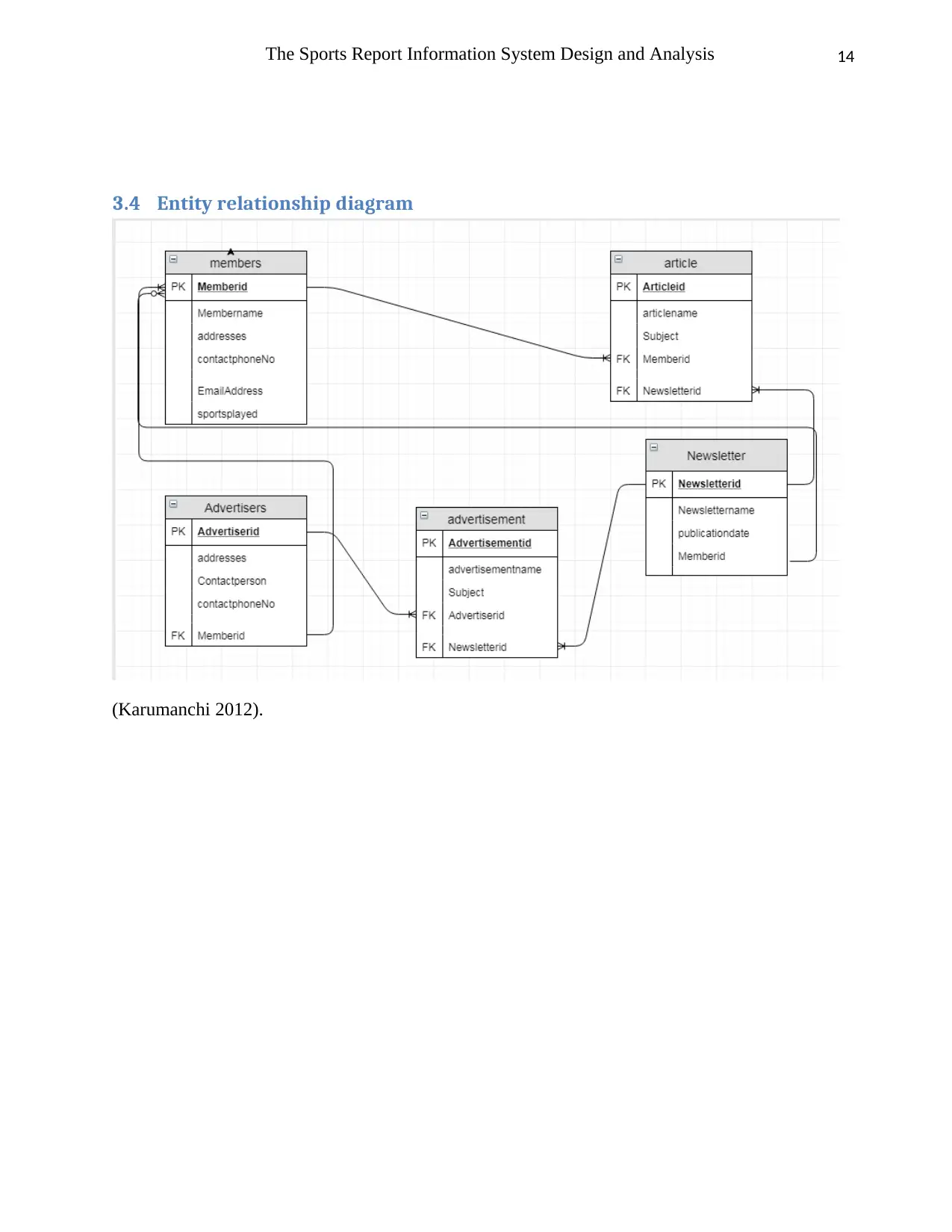
14The Sports Report Information System Design and Analysis
3.4 Entity relationship diagram
(Karumanchi 2012).
3.4 Entity relationship diagram
(Karumanchi 2012).
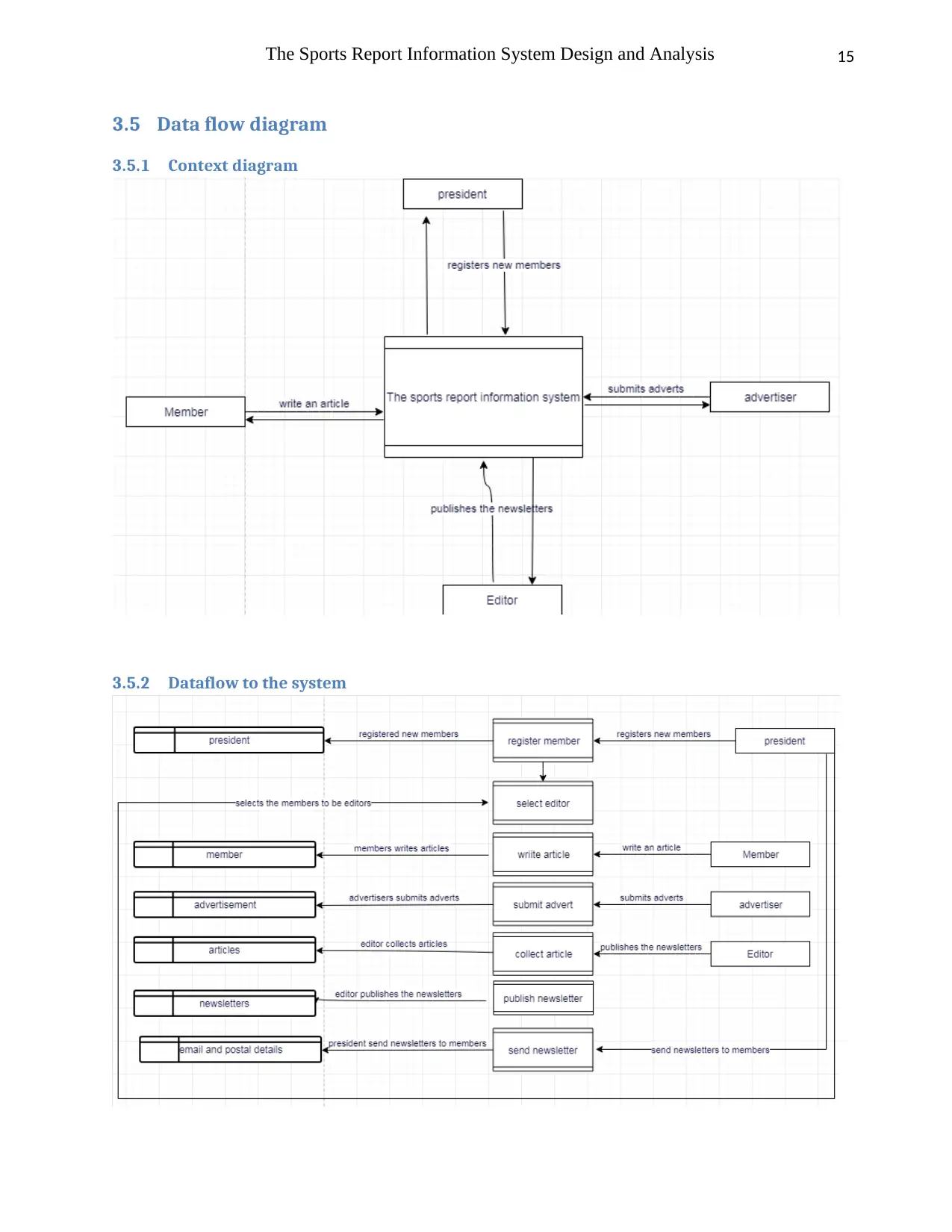
15The Sports Report Information System Design and Analysis
3.5 Data flow diagram
3.5.1 Context diagram
3.5.2 Dataflow to the system
3.5 Data flow diagram
3.5.1 Context diagram
3.5.2 Dataflow to the system
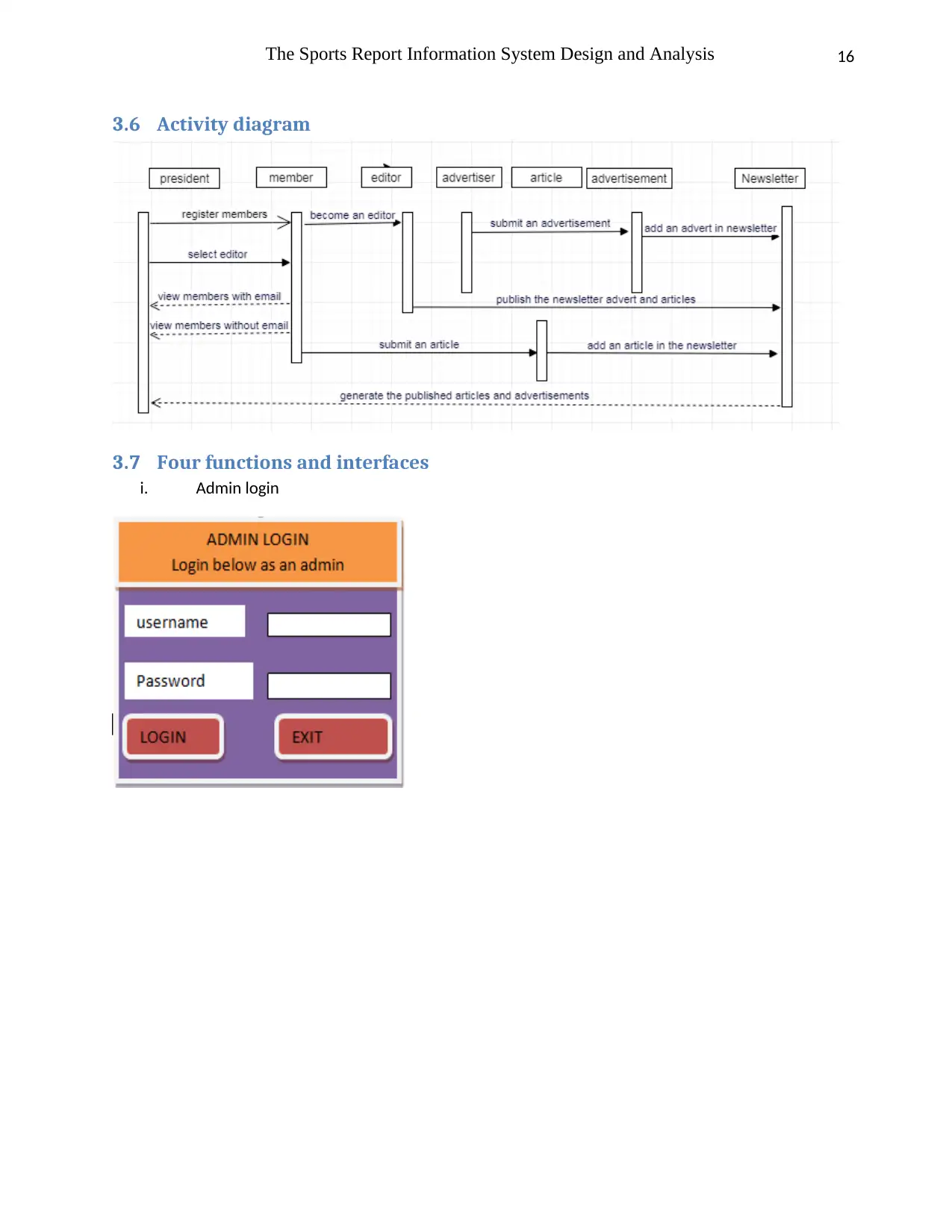
16The Sports Report Information System Design and Analysis
3.6 Activity diagram
3.7 Four functions and interfaces
i. Admin login
3.6 Activity diagram
3.7 Four functions and interfaces
i. Admin login
Secure Best Marks with AI Grader
Need help grading? Try our AI Grader for instant feedback on your assignments.
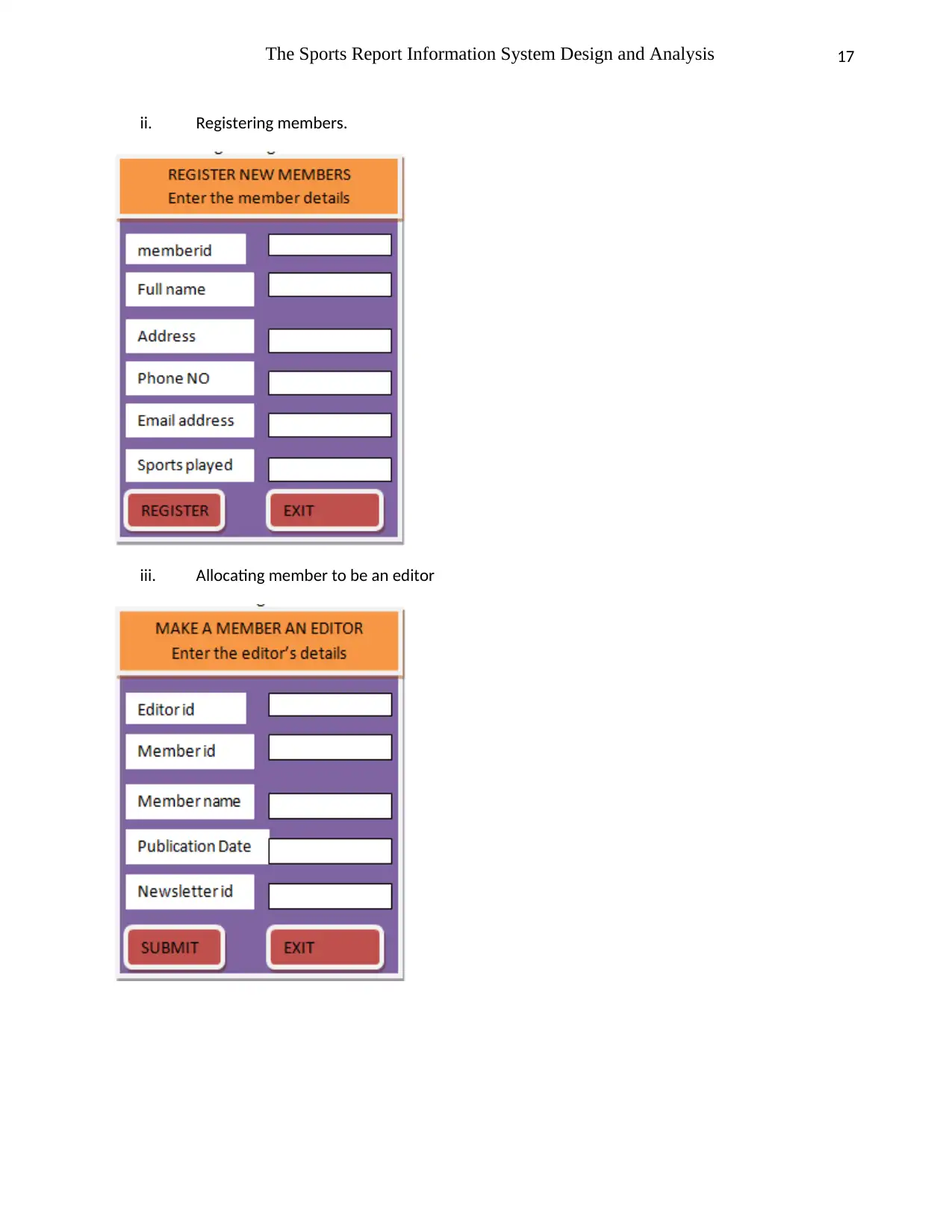
17The Sports Report Information System Design and Analysis
ii. Registering members.
iii. Allocating member to be an editor
ii. Registering members.
iii. Allocating member to be an editor
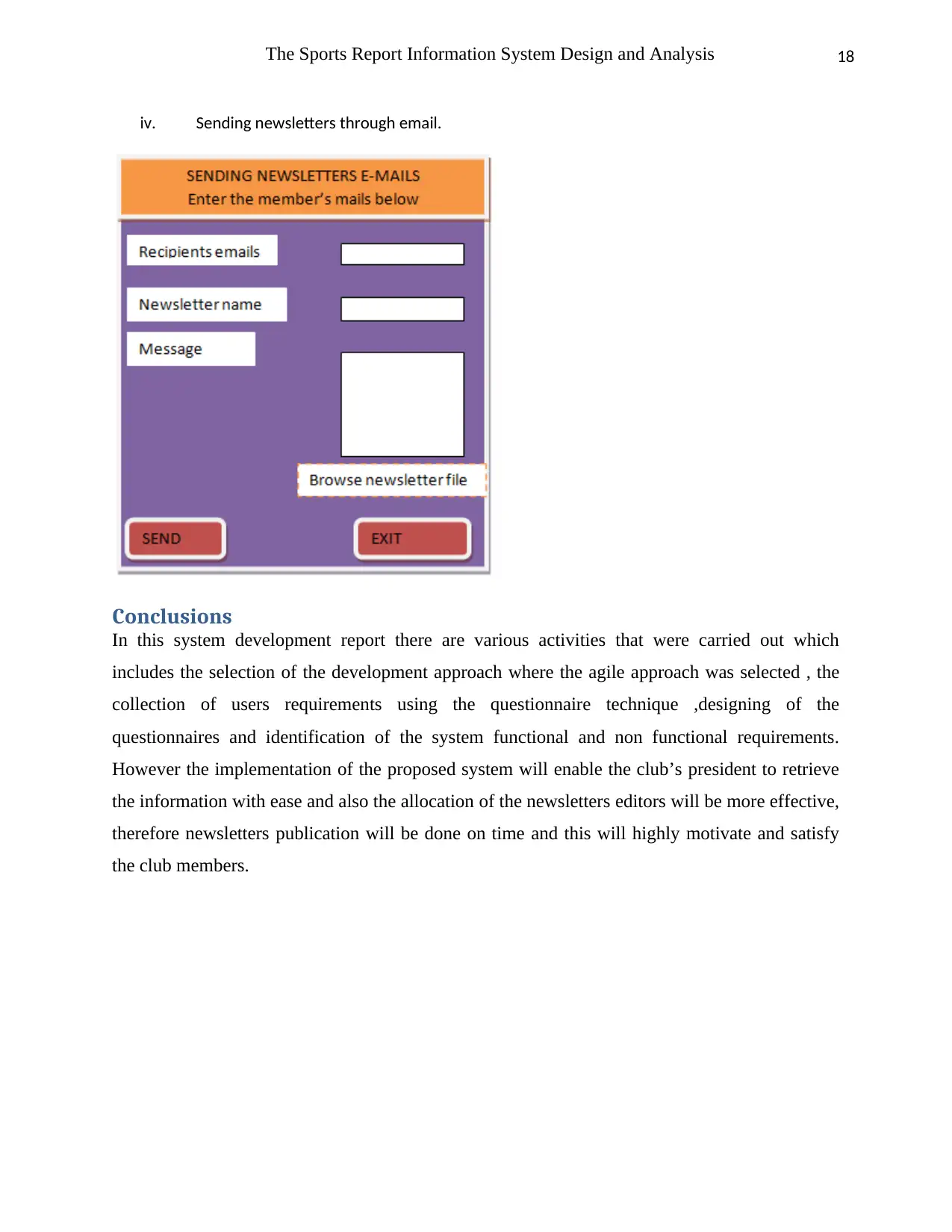
18The Sports Report Information System Design and Analysis
iv. Sending newsletters through email.
Conclusions
In this system development report there are various activities that were carried out which
includes the selection of the development approach where the agile approach was selected , the
collection of users requirements using the questionnaire technique ,designing of the
questionnaires and identification of the system functional and non functional requirements.
However the implementation of the proposed system will enable the club’s president to retrieve
the information with ease and also the allocation of the newsletters editors will be more effective,
therefore newsletters publication will be done on time and this will highly motivate and satisfy
the club members.
iv. Sending newsletters through email.
Conclusions
In this system development report there are various activities that were carried out which
includes the selection of the development approach where the agile approach was selected , the
collection of users requirements using the questionnaire technique ,designing of the
questionnaires and identification of the system functional and non functional requirements.
However the implementation of the proposed system will enable the club’s president to retrieve
the information with ease and also the allocation of the newsletters editors will be more effective,
therefore newsletters publication will be done on time and this will highly motivate and satisfy
the club members.
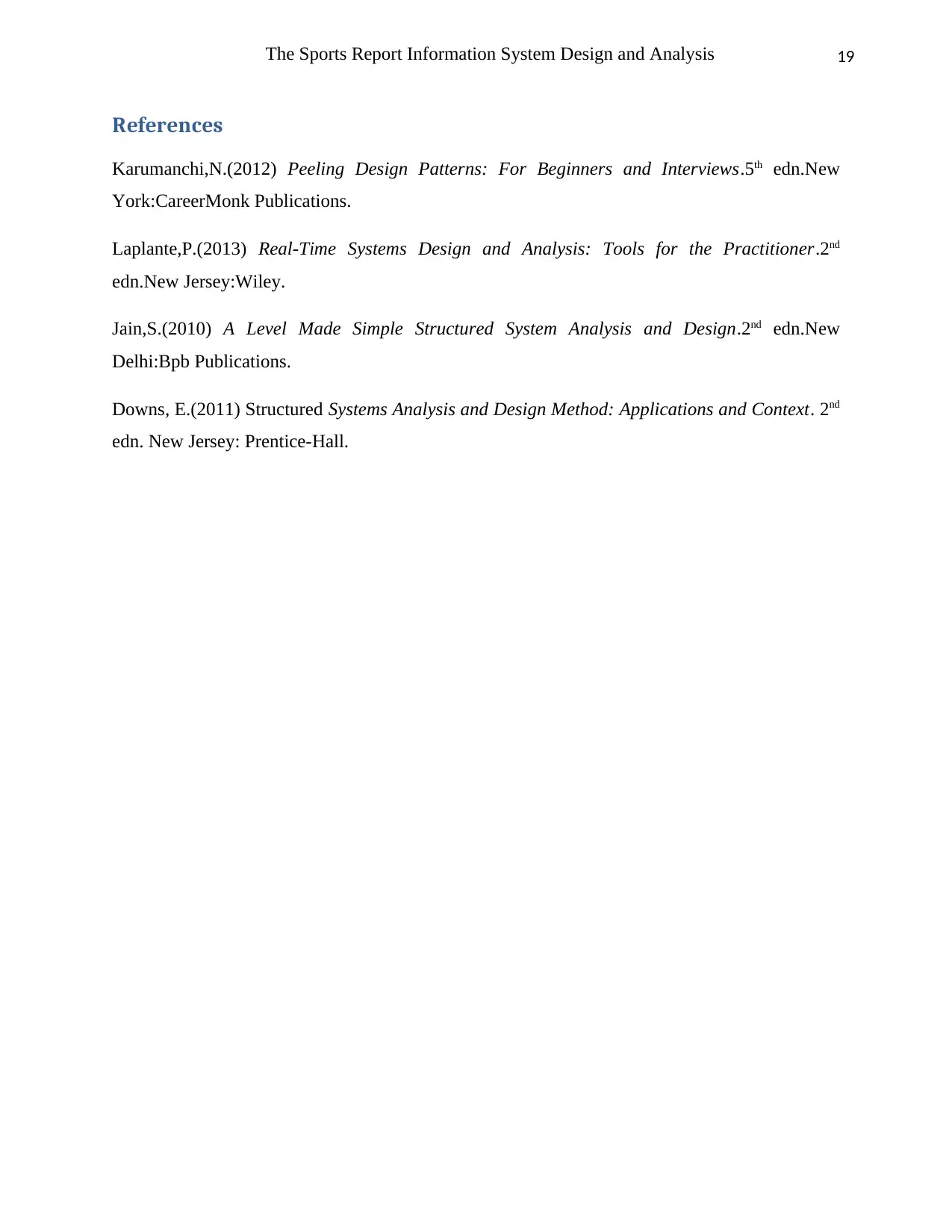
19The Sports Report Information System Design and Analysis
References
Karumanchi,N.(2012) Peeling Design Patterns: For Beginners and Interviews.5th edn.New
York:CareerMonk Publications.
Laplante,P.(2013) Real-Time Systems Design and Analysis: Tools for the Practitioner.2nd
edn.New Jersey:Wiley.
Jain,S.(2010) A Level Made Simple Structured System Analysis and Design.2nd edn.New
Delhi:Bpb Publications.
Downs, E.(2011) Structured Systems Analysis and Design Method: Applications and Context. 2nd
edn. New Jersey: Prentice-Hall.
References
Karumanchi,N.(2012) Peeling Design Patterns: For Beginners and Interviews.5th edn.New
York:CareerMonk Publications.
Laplante,P.(2013) Real-Time Systems Design and Analysis: Tools for the Practitioner.2nd
edn.New Jersey:Wiley.
Jain,S.(2010) A Level Made Simple Structured System Analysis and Design.2nd edn.New
Delhi:Bpb Publications.
Downs, E.(2011) Structured Systems Analysis and Design Method: Applications and Context. 2nd
edn. New Jersey: Prentice-Hall.
1 out of 19
Related Documents
Your All-in-One AI-Powered Toolkit for Academic Success.
+13062052269
info@desklib.com
Available 24*7 on WhatsApp / Email
![[object Object]](/_next/static/media/star-bottom.7253800d.svg)
Unlock your academic potential
© 2024 | Zucol Services PVT LTD | All rights reserved.





